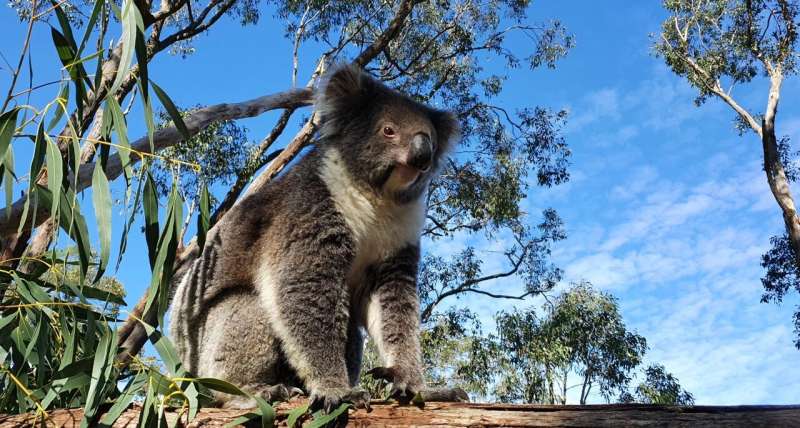Major push to save Australia's koalas

Koalas—designated an endangered species in NSW, ACT and Queensland—are abundant in some parts of South Australia and Victoria, with Flinders University researchers now assessing whether their success in southern Australia can help save the species.
Once widespread across the south coast of SA and Western Australia, koalas have retreated thousands of years ago to the eastern forests of Australia, from north Queensland in a thick band down the coast of NSW, across most of Victoria, with just a small population in the south-eastern corner of SA, says Associate Professor Danielle Clode, author of a new book, "Koala: A Life in Trees" (Black Inc).
More recently, they've made a remarkable comeback to Kangaroo Island and the Mt Lofty Ranges in SA, as well as safe "refuge" areas of Victoria.
The Adelaide Hills and Mount Lofty Ranges now have some of the densest populations of koalas in the country, with Belair National Park hosting as many as 14 koalas per hectare, she says.
"They are so abundant that in recent years they have moved into the suburbs (of Adelaide), traveling along linear parks from the foothill forests into residential gardens and city parklands," says Associate Professor Clode, who will MC the NSW State Koala Conference in Coffs Harbor this weekend.
"It's a far cry from some populations in inland Queensland, where barely a single koala per 100 hectares can be found."
Faced with the threat of extinction along the eastern seaboard, the koala conference (27 October 2022) is a summit of scientists, conservation groups and concerned citizens aiming to raise awareness of dramatic corrective action needed to save wild koalas in NSW—as well as other states.
"We really need to increase protection for old trees from development in the suburbs to protect our unique city koala populations, but more importantly, across the board, we need to increase and restore forest vegetation along creeklines and rivers to support biodiversity," she says.
"These areas are breeding grounds and nurseries for many species, including mammals, so we need to set targets to stop land clearance and increase the extent of native vegetation from 10% in the Mt Lofty Ranges to about 30% if we are not to lose more species over the next few decades."
At the Koala Conference, biologist and natural history author Associate Professor Clode will speak on habitat loss and bushfire recovery, covering some of the main points from her new book which draws on research on ecology, paleontology, morphology and archaeology by several other Flinders scientists.
"What can we learn from the southern koalas' success to help protect their northern cousins," she asks.
"The Black Summer Bushfires of 2019–20 reduced the Kangaroo Island population by 80%, or more than 40,000 koalas, after an estimated 5000 or more were killed across NSW where a quarter of their habitat was destroyed.
"With climate change as well as regular deaths by dog attacks and cars, we need to take a more serious look at their long-term survival."
Land clearance, hunting and devastating bushfires in the 1930s and 1940s almost wiped koalas out entirely in south-eastern Australia, except for small remnant populations in the Otways and Strzelecki Ranges, and a handful of koalas transported to islands in Western Port, south of Melbourne, in a last ditch effort by locals to save the species.
She warns these refuge populations on Kangaroo Island and other areas of southern Australia are still at grave risk, not least from further bushfire devastation, deforestation and climate change.
Flinders University researchers, from the College of Science and Engineering, have conducting extensive studies of local populations, focusing on the Adelaide and Mt Lofty Ranges and Kangaroo Island, both before and since the devastating Black Summer bushfires.
A Flinders research team led by Professor Karen Burke da Silva recently counted more than 100 koalas in the Belair National Park, and have continued monitoring koalas rescued from the bushfires.
Provided by Flinders University



















